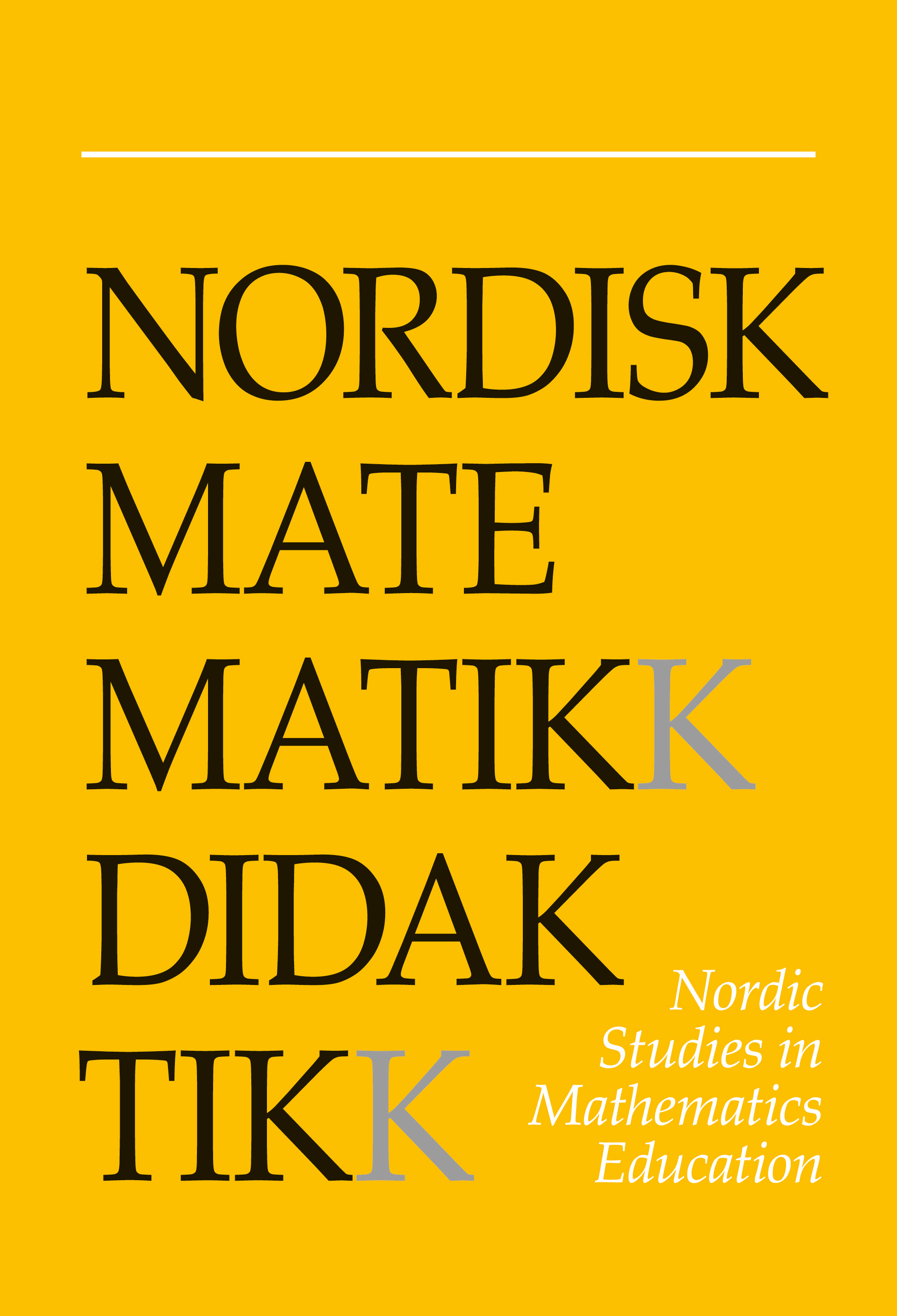Mathematics lecturers’ views on the teaching of mathematical modelling
DOI:
https://doi.org/10.7146/nomad.v22i4.148923Abstract
The paper reports on the views and use of mathematical modelling (MM) in university mathematics courses in Norway from the perspective of lecturers. Our analysis includes a characterisation of MM views based on the modelling perspectives developed by Kaiser and Sriraman (2006). Through an online survey we aimed to identify the main perspectives held in higher education by mathematics lecturers and the underlying rationale for integrating (or not) MM in university courses. The results indicated that most respondents displayed a realistic perspective on MM when it came to their professional practice. There was a more varied response when it came to their views on MM in teaching. Regarding conditions influencing the use or non-use of MM in teaching, these mainly concerned the mathematical content and the institutional practices.
References
Barbosa, J.C. (2006). Mathematical modelling in classroom: a critical and discursive perspective. ZDM, 38 (3), 293-301. https://doi.org/10.1007/BF02652812
Blum, W. & Leiß, D. (2006). "Filling up" - the problem of independence- preserving teacher interventions in lessons with demanding modelling tasks. In M. Bosch (Ed.), Proceedings of the 4th European Congress of Mathematics Education (pp. 1623-1633). St. Feliu de Guixols: CERME.
Blum, W. & Niss, M. (1991). Applied mathematical problem solving, modelling, applications, and links to other subjects: state, trends and issues in mathematics instruction. Educational Studies in Mathematics, 22 (1), 37-68. https://doi.org/10.1007/BF00302716
Blum, W., Galbraith, P.L., Henn, H. & Niss, M. (Eds.) (2007). Modelling and applications in mathematics education (The 14th ICMI study). New York: Springer. https://doi.org/10.1007/978-0-387-29822-1
Burkhardt, H. (2006). Modelling in mathematics classrooms: reflections on past developments and the future. ZDM, 38 (2), 178-195. https://doi.org/10.1007/BF02655888
Cohen, L., Manion, L. & Morrison, K. (2008). Research methods in education. London: Routledge. https://doi.org/10.4324/9780203029053
D'Ambrosio, U. (1999). Literacy, matheracy and technocracy: a trivium for today. Mathematical Thinking and Learning, 1 (2), 131-153. https://doi.org/10.1207/s15327833mtl0102_3
Dorier, J.-L. (2006). An introduction to mathematical modelling - an experiment with students in economics. In M. Bosch (Ed.), Proceedings of the 4th European Congress of Mathematics Education (pp. 1634-1644). St. Feliu de Guixols: CERME.
Dym, C. (2004). Principles of mathematical modeling (2nd edition). San Diego: Elsevier. https://doi.org/10.1016/B978-012226551-8/50002-8
Frejd, P. (2011). Mathematical modelling in upper secondary school in Sweden: an exploratory study (Licentiate thesis). Linköping University.
Freudenthal, H. (1983). Didactical phenomenology of mathematical structures. Dordrecht: Kluwer.
Garcia F. J. & Ruiz, L. (2006). Mathematical praxeologies of increasing complexity: variation systems modelling in secondary education. In M. Bosch (Ed.), Proceedings of the 4th European Congress of Mathematics Education (pp. 1645-1654). St. Feliu de Guixols: CERME.
Garcia, F. J., Gascón, J., Ruiz, L. & Bosch, M. (2006). Mathematical modelling as a tool for the connection of school mathematics. ZDM, 38 (3), 226-246. https://doi.org/10.1007/BF02652807
Giordano, F. R., Fox, W. P. & Horton, S. B. (2013). A first course in mathematical modeling (5th edition). Belmont: Brooks/Cole.
Hadamard, J. (1954). The psychology of invention in the mathematical field. New York: Dover Publications.
Hardy, G.H. (1940). A mathematician's apology. Cambridge: Cambridge University Press.
Jablonka, E. & Gellert, U. (2007). Mathematisation - demathematisation. In U. Gellert & E. Jablonka (Eds.). Mathematisation and demathematisation: social, philosophical and educational ramifications (pp. 1-18). Rotterdam: Sense Publishers. https://doi.org/10.1163/9789460911439_002
Kaiser, G. & Sriraman, B. (2006). A global survey of international perspectives on modelling in mathematics education. ZDM, 38 (3), 302-310. https://doi.org/10.1007/BF02652813
Lesh, R. & Doerr, H. (Eds.) (2003). Beyond constructivism: a models and modeling perspective on mathematics problem solving, learning, and teaching. Mahwah: Lawrence Erlbaum Associates. https://doi.org/10.4324/9781410607713
Lesh, R. & Sriraman, B. (2005). Mathematics education as a design science. ZDM, 37 (6), 490-505. https://doi.org/10.1007/BF02655858
Niss, M. (2003). Mathematical competencies and the learning of mathematics: the Danish KOM project. In A. Gagatsis & S. Papastravidis (Eds.), 3rd Mediterranean Conference on Mathematics Education (pp. 115-124), Athens: Hellenic Mathematical Society and Cyprus Mathematical Society.
Poincaré, H. (1952). Science and method. New York: Dover Publications.
Pollak, H. (2015). The place of mathematical modeling in mathematics education. In G. A. Stillman, W. Blum & M. Salett Biembengut (Eds.), Mathematical modelling in education research and practice: cultural, social and cognitive influences (pp. 265-276). New York: Springer.
Pólya, G. (1957). How to solve it. Princeton: Princeton University Press.
Shiflet, A. B. & Shiflet, G. W. (2014). Introduction to computational science: modeling and simulation for the sciences (2nd edition). Princeton: Princeton University Press.
Soon, W., Tirtasanjaya, L. & McInnes, B. (2011). Understanding the difficulties faced by engineering undergraduates in learning mathematical modelling. International Journal of Mathematical Education in Science and Technology, 42 (8), 1021-1039. https://doi.org/10.1080/0020739X.2011.573867
Treffers, A. (1987). Three dimensions: a model of goal and theory descriptions in mathematics instruction - the Wiskobas project. Dordrecht: Kluwer. https://doi.org/10.1007/978-94-009-3707-9
Velten, K. (2009). Mathematical modeling and simulation: introduction for scientists and engineers. Weinheim: Wiley-VCH. https://doi.org/10.1002/9783527627608
Downloads
Published
How to Cite
Issue
Section
License

This work is licensed under a Creative Commons Attribution-NonCommercial-ShareAlike 4.0 International License.



